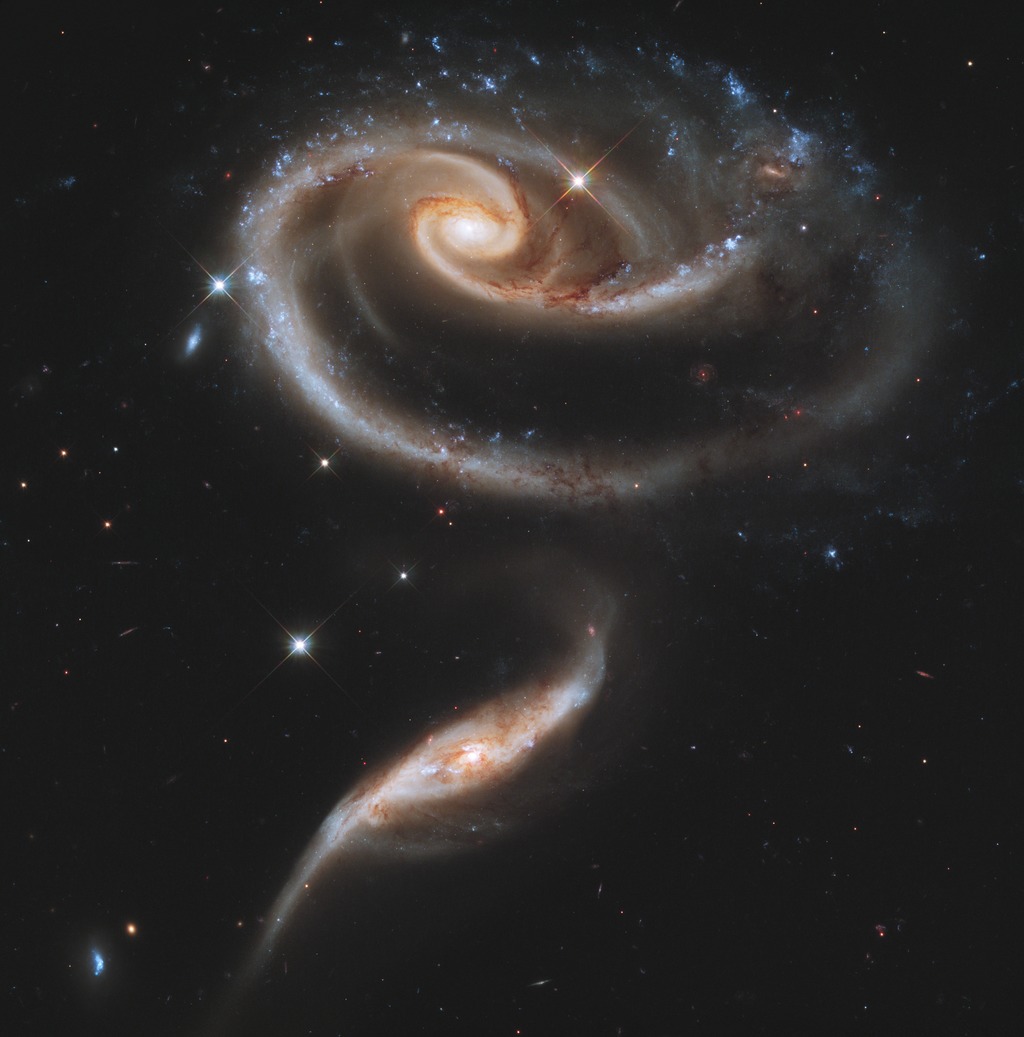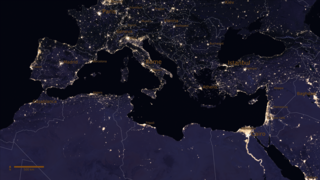Universe
ID: 30857

The NASA Hubble Space Telescope turned its keen eye to an especially photogenic group of interacting galaxies called Arp 273.
The larger of the spiral galaxies, known as UGC 1810, has a disk that is tidally distorted into a rose-like shape by the gravitational tidal pull of the companion galaxy below it, known as UGC 1813. A swath of blue jewels across the top is the combined light from clusters of intensely bright and hot young blue stars. These massive stars glow fiercely in ultraviolet light.
The smaller, nearly edge-on companion shows distinct signs of intense star formation at its nucleus, perhaps triggered by the encounter with the companion galaxy.
A series of uncommon spiral patterns in the large galaxy is a tell-tale sign of interaction. The large, outer arm appears partially as a ring, a feature seen when interacting galaxies actually pass through one another. This suggests that the smaller companion actually dived deep, but off-center, through UGC 1810. The inner set of spiral arms is highly warped out of the plane with one of the arms going behind the bulge and coming back out the other side. How these two spiral patterns connect is still not precisely known.
The larger galaxy in the UGC 1810 - UGC 1813 pair has a mass that is about five times that of the smaller galaxy. In unequal pairs such as this, the relatively rapid passage of a companion galaxy produces the lopsided or asymmetric structure in the main spiral. Also in such encounters, the starburst activity typically begins in the minor galaxies earlier than in the major galaxies.
Arp 273 lies in the constellation Andromeda and is roughly 300 million light-years away from Earth. The image shows a tenuous tidal bridge of material between the two galaxies that are separated by tens of thousands of light-years from each other.
This Hubble image is a composite of data taken with three separate filters that allow a broad range of wavelengths covering the ultraviolet, blue, and red portions of the spectrum.
Interacting Galaxies Arp 273 from Hubble

The larger of the spiral galaxies, known as UGC 1810, has a disk that is tidally distorted into a rose-like shape by the gravitational tidal pull of the companion galaxy below it, known as UGC 1813. A swath of blue jewels across the top is the combined light from clusters of intensely bright and hot young blue stars. These massive stars glow fiercely in ultraviolet light.
The smaller, nearly edge-on companion shows distinct signs of intense star formation at its nucleus, perhaps triggered by the encounter with the companion galaxy.
A series of uncommon spiral patterns in the large galaxy is a tell-tale sign of interaction. The large, outer arm appears partially as a ring, a feature seen when interacting galaxies actually pass through one another. This suggests that the smaller companion actually dived deep, but off-center, through UGC 1810. The inner set of spiral arms is highly warped out of the plane with one of the arms going behind the bulge and coming back out the other side. How these two spiral patterns connect is still not precisely known.
The larger galaxy in the UGC 1810 - UGC 1813 pair has a mass that is about five times that of the smaller galaxy. In unequal pairs such as this, the relatively rapid passage of a companion galaxy produces the lopsided or asymmetric structure in the main spiral. Also in such encounters, the starburst activity typically begins in the minor galaxies earlier than in the major galaxies.
Arp 273 lies in the constellation Andromeda and is roughly 300 million light-years away from Earth. The image shows a tenuous tidal bridge of material between the two galaxies that are separated by tens of thousands of light-years from each other.
This Hubble image is a composite of data taken with three separate filters that allow a broad range of wavelengths covering the ultraviolet, blue, and red portions of the spectrum.
For More Information
Credits
Please give credit for this item to:
NASA, ESA, and the Hubble Heritage Team (STScI/AURA)
NASA, ESA, and the Hubble Heritage Team (STScI/AURA)
Short URL to share this page:
https://svs.gsfc.nasa.gov/30857
Mission:
Hubble
Keywords:
SVS >> Galaxy
SVS >> Hyperwall
SVS >> Hubble Space Telescope
SVS >> Astronomy
NASA Science >> Universe
SVS >> Presentation
https://svs.gsfc.nasa.gov/30857
Mission:
Hubble
Keywords:
SVS >> Galaxy
SVS >> Hyperwall
SVS >> Hubble Space Telescope
SVS >> Astronomy
NASA Science >> Universe
SVS >> Presentation











